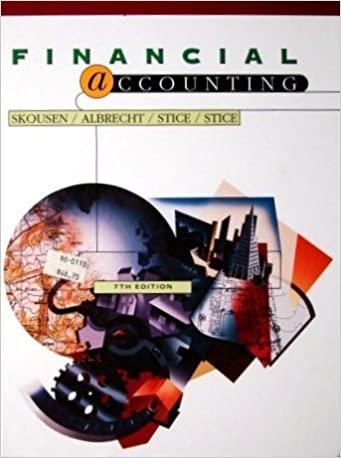Question
1 A company adopts a job-order costing system. What year-end journal entry could it make to dispose of $4,150 of overapplied manufacturing overhead cost? (A)
1
A company adopts a job-order costing system. What year-end journal entry could it make to dispose of $4,150 of overapplied manufacturing overhead cost?
-
(A) Dr Finished Goods $4,150 Cr Manufacturing Overhead. $4,150
-
(B) Dr Cost of Goods Sold. $4,150. Cr Manufacturing Overhead. $4,150
-
(C) Dr Manufacturing Overhead. $4,150 Cr Finished Goods $4,150
-
(D) Dr Manufacturing Overhead $4,150. Cr Cost of Goods Sold. $4,150
2. In process costing, a transferred-in cost is
-
(A) a cost transferred from an earlier department.
-
(B) a cost which has been transferred in from the vendor who has supplied the raw materials.
-
(C) the cost of the labor that has been added to the process during the month.
-
(D) the conversion costs which were included in the beginning work in process inventory.
3. Examples of a typical cost driver include
-
(A) machine hours.
-
(B) direct labor hours.
-
(C) number of purchase orders issued.
-
(D) All of the above.
-
4 An engineering firm has surplus capacity and intents to secure a short-term contract to supply components. It has decided to bid for the contract at a price which will just cover all relevant costs.
Which ONE of the following costs should be included in the calculation of the minimum price it can bid?
-
(A) The cost of hiring a supervisor to oversee the contracts progress.
-
(B) The cost of a research project undertaken last year which has resulted in an improved method of manufacturing components.
-
(C) The cost of labor which will be transferred to the contract from another production line where it is currently idle.
-
(D) The depreciation charge on existing machinery owned by the firm which will be used to manufacture the components.
-
-
5 Which of the following statements are correct with regard to marginal costing?
-
(i) Period costs are costs treated as expenses in the period incurred.
-
(ii) Product costs can be identified with goods produced.
-
(iii) Unavoidable costs are relevant for decision making.
-
(A) (i) and (ii) only
-
(B) (i) and (iii) only
-
(C) (ii) and (iii) only
-
(D) (i), (ii) and (iii)
-
-
6 In a period, opening stocks were 12,600 units and closing stocks 14,100 units. The profit based on marginal costing was $50,400 and profit using absorption costing was $60,150. The fixed overhead absorption rate per unit is
-
(A) $4.77.
-
(B) $6.50.
-
(C) $6.77.
-
(D) None of the above
-
3
-
7 Under the FIFO process costing method, the two categories of completed units used to compute the total cost of units completed during a period are
-
(A) beginning work-in-process units and units started
-
(B) units started and completed and ending work-in-process units.
-
(C) beginning work-in-process units and units started and completed during the current period.
-
(D) None of the above
-
The following are the different methods used to assign overhead costs to cost objects:
-
(i) plantwide rate
-
(ii) departmental rate
-
(iii) activity-based costing activity rate
Rank these methods of assigning overhead costs from least accurate to most accurate:
-
(A) (i), (ii), (iii)
-
(B) (ii), (i), (iii)
-
(C) (i), (iii), (ii)
-
(D) (iii), (ii), (i)
-
-
9 Which of the following costs are always irrelevant in decision making?
-
(A) Avoidable costs
-
(B) Sunk costs
-
(C) Opportunity costs
-
(D) Fixed costs
-
-
10 Research has shown that managers perform best when
-
(A) there is no budget to worry about.
-
(B) budgets contain a maximum of slack.
-
(C) there is a moderately difficult but achievable budget.
-
(D) the budget is obviously unachievable, but presents a tremendous challenge.
-
4
-
Step by Step Solution
There are 3 Steps involved in it
Step: 1

Get Instant Access to Expert-Tailored Solutions
See step-by-step solutions with expert insights and AI powered tools for academic success
Step: 2

Step: 3

Ace Your Homework with AI
Get the answers you need in no time with our AI-driven, step-by-step assistance
Get Started


